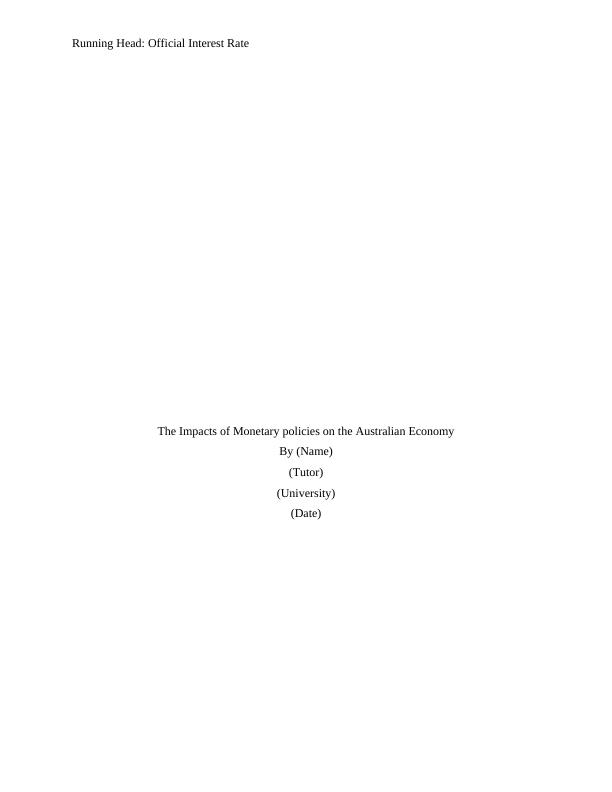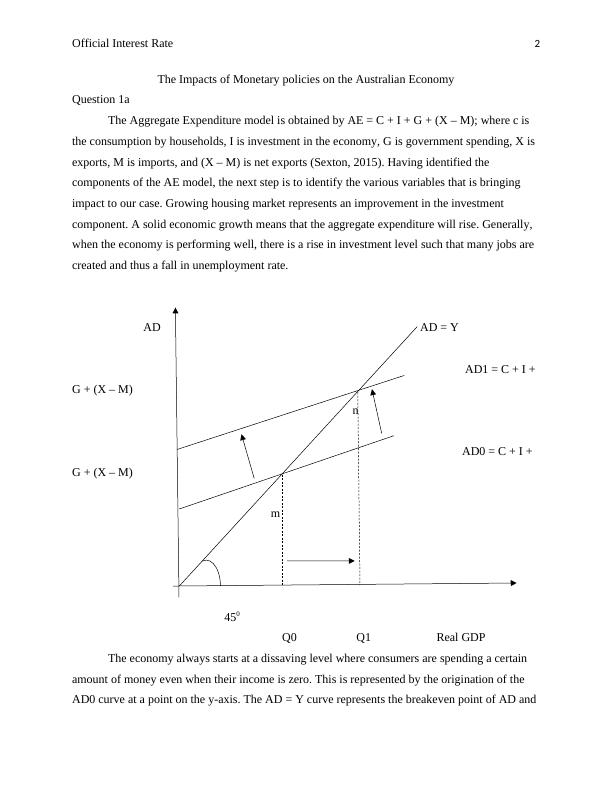The Impacts of Monetary Policies on the Australian Economy
Added on 2023-06-04
7 Pages1924 Words465 Views
Running Head: Official Interest Rate
The Impacts of Monetary policies on the Australian Economy
By (Name)
(Tutor)
(University)
(Date)
The Impacts of Monetary policies on the Australian Economy
By (Name)
(Tutor)
(University)
(Date)

Official Interest Rate 2
The Impacts of Monetary policies on the Australian Economy
Question 1a
The Aggregate Expenditure model is obtained by AE = C + I + G + (X – M); where c is
the consumption by households, I is investment in the economy, G is government spending, X is
exports, M is imports, and (X – M) is net exports (Sexton, 2015). Having identified the
components of the AE model, the next step is to identify the various variables that is bringing
impact to our case. Growing housing market represents an improvement in the investment
component. A solid economic growth means that the aggregate expenditure will rise. Generally,
when the economy is performing well, there is a rise in investment level such that many jobs are
created and thus a fall in unemployment rate.
AD AD = Y
AD1 = C + I +
G + (X – M)
n
AD0 = C + I +
G + (X – M)
m
450
Q0 Q1 Real GDP
The economy always starts at a dissaving level where consumers are spending a certain
amount of money even when their income is zero. This is represented by the origination of the
AD0 curve at a point on the y-axis. The AD = Y curve represents the breakeven point of AD and
The Impacts of Monetary policies on the Australian Economy
Question 1a
The Aggregate Expenditure model is obtained by AE = C + I + G + (X – M); where c is
the consumption by households, I is investment in the economy, G is government spending, X is
exports, M is imports, and (X – M) is net exports (Sexton, 2015). Having identified the
components of the AE model, the next step is to identify the various variables that is bringing
impact to our case. Growing housing market represents an improvement in the investment
component. A solid economic growth means that the aggregate expenditure will rise. Generally,
when the economy is performing well, there is a rise in investment level such that many jobs are
created and thus a fall in unemployment rate.
AD AD = Y
AD1 = C + I +
G + (X – M)
n
AD0 = C + I +
G + (X – M)
m
450
Q0 Q1 Real GDP
The economy always starts at a dissaving level where consumers are spending a certain
amount of money even when their income is zero. This is represented by the origination of the
AD0 curve at a point on the y-axis. The AD = Y curve represents the breakeven point of AD and

Official Interest Rate 3
real GDP. The equilibrium in the economy is obtained by the intersection of the AD and the AD
= Y line. The initial position of this economy is at m where AD0 intersects with AD = Y; at this
point, the output level is equal to Q0 (Mceachern, 2011). A rise in the demand for houses will
raise the investment component of the AE; on the other side, a sound economic growth will raise
the investment and consumption component of the economy. Since these components are
increased, the AE curve will shift outward to reflect this increase; the shift will be from AD0 to
AD1 (Bénassy, 2011). A new equilibrium level n is reached at after this increment. At the new
equilibrium level, Aggregate demand is high, and the real GDP is also higher; it has improved
from Q0 to Q1.
Question 1b
The OECD has noted that the Australian housing market is on heat and there exist
economical risks from this. An example is the US housing bubble which was the source of the
Global recession which was experienced worldwide in 2008 -2009. What is making the housing
market more attractive is the low interest rate where people have taken advantage of the low
costs of borrowing (Duff, 2017). It’s the dream of each person to own a house and thus whenever
that chance is presented to them, they usually seizing it. The ideal of raising the official interest
rate in Australia is to ensure that the cost of lending goes up and that people will avoid
borrowing and thus the demand for houses will fall (Ivan, 2017). However, this may not have a
significant effect in the short run because most investors observe the state of the economy in
order to determine the direction in which the interest rate is likely to move. The current
Australian inflation rate is low and thus investors have no expectations of rate hikes, thus they
may continue borrowing. However, after the raise of official interest rate, new investors will be
discouraged and may decide to wait until the rate falls again (Johnston, 2017). This move to rate
hikes will affect the investment and consumption function of Aggregate Demand since money
borrowed is used for either consumption or for investing.
real GDP. The equilibrium in the economy is obtained by the intersection of the AD and the AD
= Y line. The initial position of this economy is at m where AD0 intersects with AD = Y; at this
point, the output level is equal to Q0 (Mceachern, 2011). A rise in the demand for houses will
raise the investment component of the AE; on the other side, a sound economic growth will raise
the investment and consumption component of the economy. Since these components are
increased, the AE curve will shift outward to reflect this increase; the shift will be from AD0 to
AD1 (Bénassy, 2011). A new equilibrium level n is reached at after this increment. At the new
equilibrium level, Aggregate demand is high, and the real GDP is also higher; it has improved
from Q0 to Q1.
Question 1b
The OECD has noted that the Australian housing market is on heat and there exist
economical risks from this. An example is the US housing bubble which was the source of the
Global recession which was experienced worldwide in 2008 -2009. What is making the housing
market more attractive is the low interest rate where people have taken advantage of the low
costs of borrowing (Duff, 2017). It’s the dream of each person to own a house and thus whenever
that chance is presented to them, they usually seizing it. The ideal of raising the official interest
rate in Australia is to ensure that the cost of lending goes up and that people will avoid
borrowing and thus the demand for houses will fall (Ivan, 2017). However, this may not have a
significant effect in the short run because most investors observe the state of the economy in
order to determine the direction in which the interest rate is likely to move. The current
Australian inflation rate is low and thus investors have no expectations of rate hikes, thus they
may continue borrowing. However, after the raise of official interest rate, new investors will be
discouraged and may decide to wait until the rate falls again (Johnston, 2017). This move to rate
hikes will affect the investment and consumption function of Aggregate Demand since money
borrowed is used for either consumption or for investing.

End of preview
Want to access all the pages? Upload your documents or become a member.
Related Documents
Economic Analysis - Assignment Samplelg...
|7
|1393
|105
Econometrics Study Materiallg...
|10
|1073
|26
Economy Data Analysislg...
|6
|1298
|93
The Global Economy : Assignmentlg...
|11
|1866
|57
Assignment On Impact Of Additional Monetary Stimuluslg...
|9
|1903
|27
Macroeconomicslg...
|9
|816
|490
